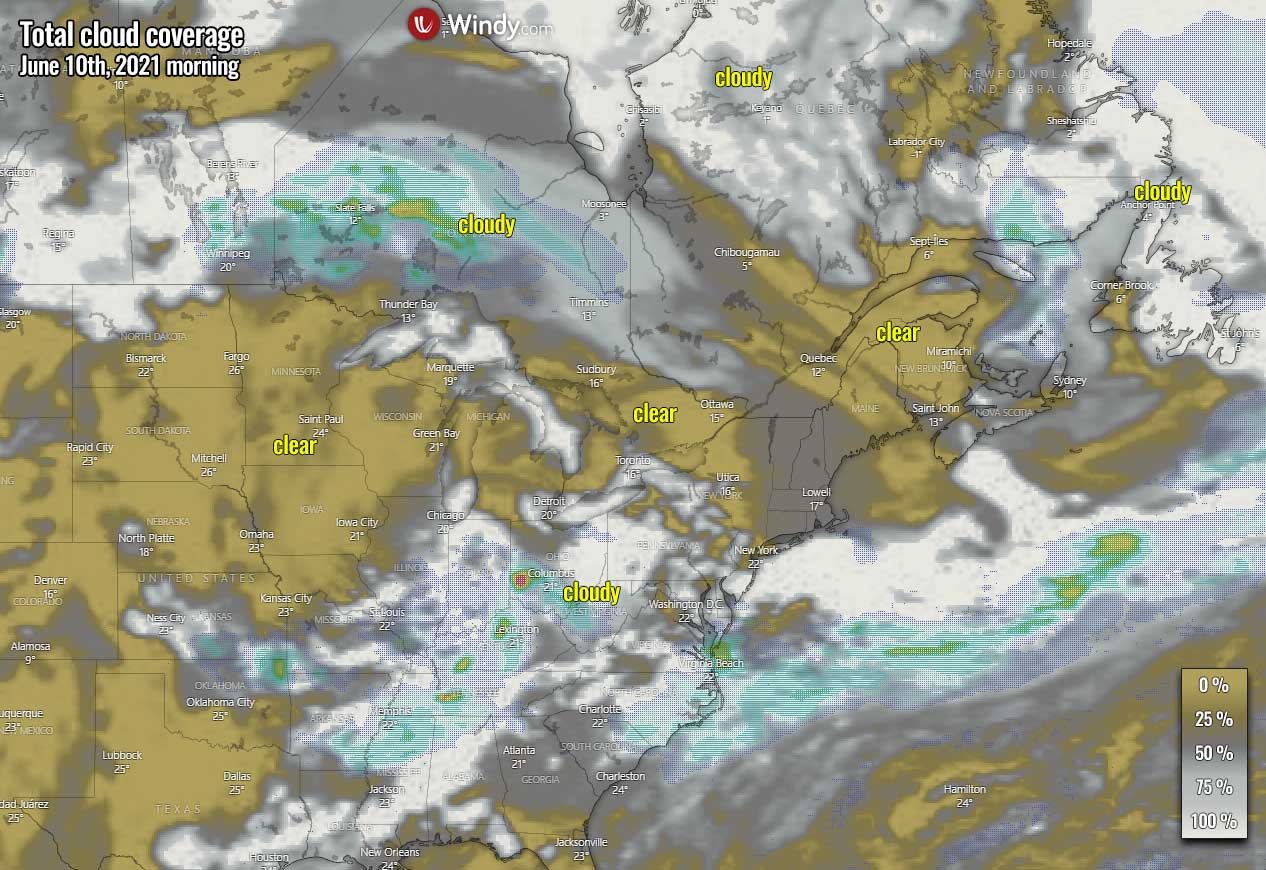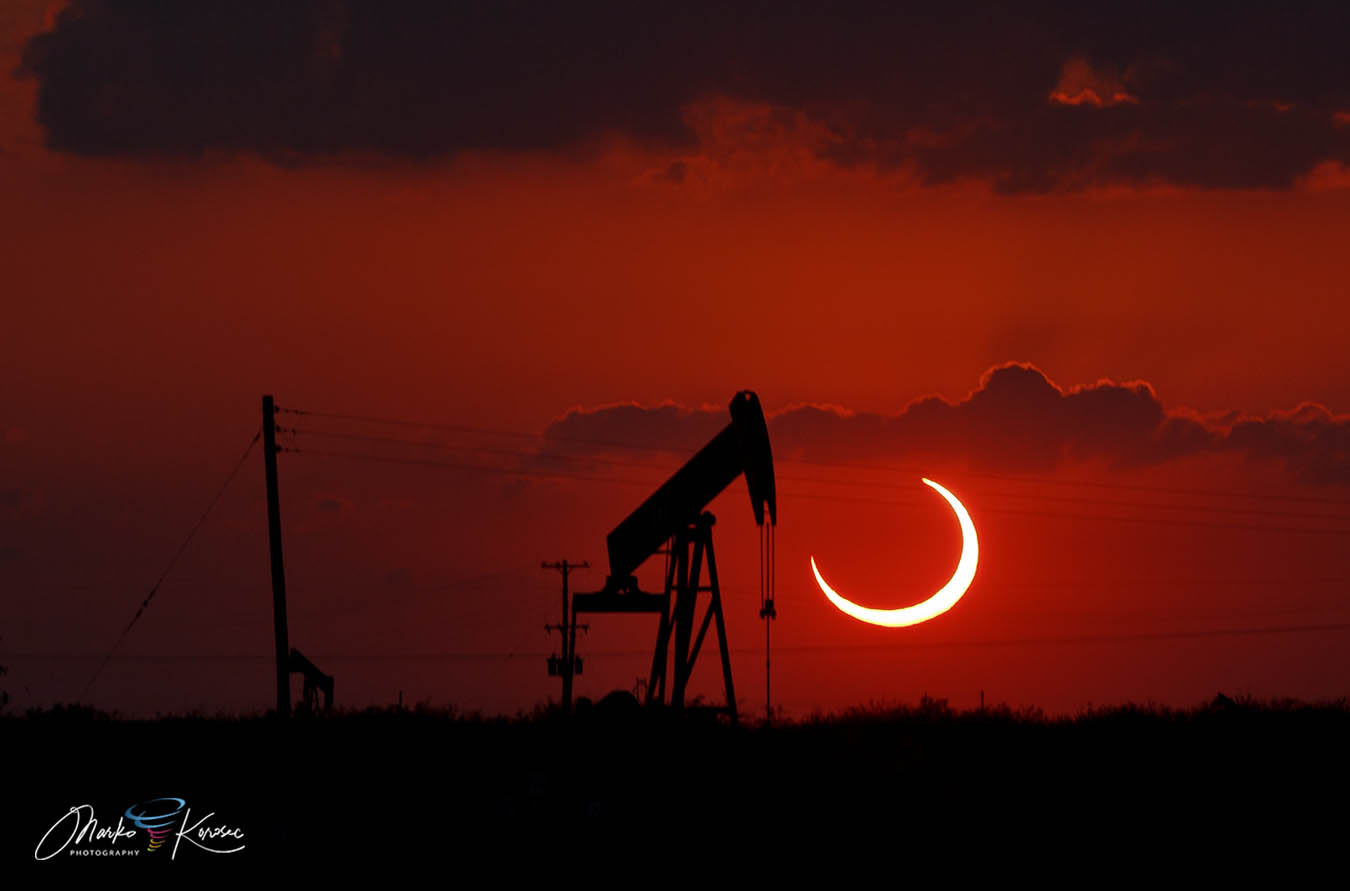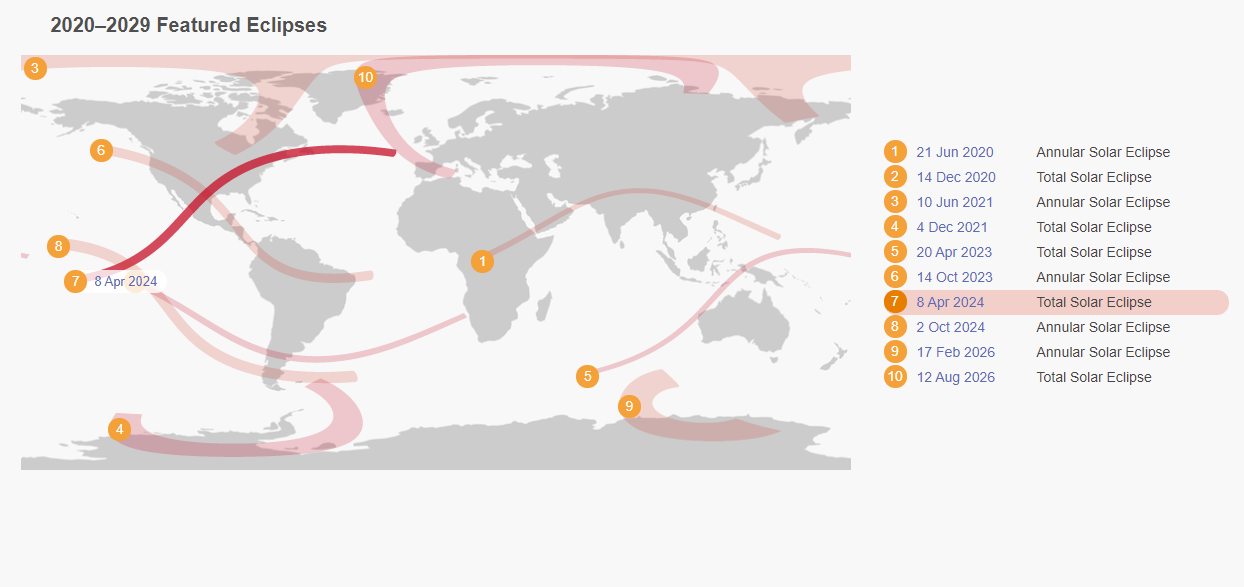Don’t forget to set up your alarm clock properly for Thursday this week. June 10th morning could be a unique and a lifetime opportunity to experience an actually very rare celestial event. A crescent sun will shine during sunrise across the northeast United States as a partial solar eclipse occurs. Further north across eastern Canada, an Annular Eclipse, known as the Ring Of Fire, will spice the sky, traveling across the Polar Region and ending up across northeast Siberia at sunset.
Here are the final thoughts and some additional tips on how to observed and photograph this unique celestial show.
For those of you who live on the Upper Peninsula of Michigan, the New York State and New England, as well as southern portions of Ontario and Quebec, the sunrise on Thursday will bring quite a show. Millions across the New York City, Boston, Toronto, Montreal will see it as our Moon will be moving across the Sun and result in the first Solar Eclipse of 2021.
As the Solar Eclipse can only happen about twice a year, and everyone is unique and happens in different, often remote areas, many people travel around the world to experience this spectacular celestial event. Total eclipses happen even more rare, about every 18 months.
Those of us who have already experienced a solar eclipse can tell you it is such a special event, you remember it forever. When the total eclipse occurs and the Sun is completely obscured by the Moon during daytime. But there is an even more spectacular and also pretty rare event, an annular solar eclipse.

Above: Annular Solar Eclipse in Texas, May 20th, 2012. Photo by Marko Korosec
Often during the eclipse, you can hear chirping birds see them going to roost like it is dusk, temperatures are cooler when the totality is closing in. On most of the totalities, observers reported shadow bands, even some silver tint can be seen in those. Many people chase the eclipses, just to experience this unique opportunity for those few precious minutes.
As our Moon’s orbit is not perfectly circular, it rounds the Earth in an elliptical way. This means that sometimes it is closer to us, while it is also quite farther away months later.
Learn what is the solar eclipse in one of our previous releases.
When the Moon is the farthest away, its diameter appears smaller than the Sun. This is when we witness an annular eclipse, a so-called Ring Of Fire Solar Eclipse. Therefore, the Moon only partially obscures the Sun’s disc and a tiny ring or halo appears around the Moon. Bright light is shining from this halo, making it a very spectacular celestial show.
Warning: Remember, NEVER look directly at the sun with an unaided eye. Not even through binoculars, your camera, or a telescope as it would cause permanent damage to your eyes. Even a short moment of concentrated light coming through the lens could be damaging.
TIMES OF THE RING OF FIRE SOLAR ECLIPSE 2021
The Annular Solar Eclipse on June 10th – Ring Of Fire – is viewable from parts of Canada, across the Hudson Bay and Greenland, over the Polar (Arctic) Region including the North Pole, and parts of northeast Russia (Siberia). The complete eclipse lasts about 1 hour and 40 minutes in total.

Above: The path of the Annular Solar Eclipse on Jun 10th, 2021. Source: Sky and telescope
From any of the areas along the swath of the Annular Solar Eclipse, the Ring Of Fire halo lasts a maximum of 3 minutes and 51 seconds.
Observers in North America, the North Atlantic, a large part of Europe, Asia, and the Arctic will be able to watch the celestial event as a Partial Solar Eclipse. The closer you live to the swath of the totality, the larger part of the Sun’s disc will be obscured by the Moon.
ECLIPSE IN NORTH AMERICA
A quite spectacular sunrise happens for millions of Americans over the Mid-Atlantic, the Great Lakes, and the Northeast United States. Although not many could see the perfect Ring Of Fire this time, it will be quite a dramatic sunrise show for sure. Hopefully with some clear skies.

Above: Path of Annularity across eastern Canada and Northeast U.S. Image: Sky and Telescope
A deeper eclipse of the Sun will remain in view for about an hour after the Sun rises on Thursday morning. In New York City the eclipse magnitude will reach 80%, which means that the Moon will cover 80 percent of the Sun’s disc.
About 73% of the Sun will be covered over Boston and about 23% in Chicago. The city of Toronto, Canada will see 80% of the Sun covered by the Moon.

Above: Eclipse-viewing area in the United States, June 10th, 2021
The eclipse ends before sunrise for the areas west of eastern South Dakota, central Iowa, southern Illinois, or central Georgia. So it will not be visible in these areas.
PARTIAL ECLIPSE OVER THE ATLANTIC AND EUROPE
A lot of Europeans will also be able to observe the partial solar eclipse from start to finish, as it will take place higher in the sky through the late morning into midday hours. The farther north in Europe you live, the deeper the partial eclipse will be. The full eclipse will last for about 2 hours and a half across northern parts of Europe, but only about an hour and a few minutes over central Europe.
The Norwegian Tromso will have 51% of the Sun covered by the Moon, Oslo will have it only about 30% covered. Glasgow, Scotland will experience similar Sun’s disc coverage, around 32%. The Faroes’ capital Thorshavn will experience about 46% during the peak of the eclipse.
The biggest part of the Sun’s disc obscured by the Moon will be over the Icelandic capital, Reykjavik. There, the coverage of 60.5% will occur, so just slightly less than two-thirds of the Sun’s disc.

Above: Eclipse viewing area in Europe, June 10th, 2021
Venice (Italy) will only see a tiny part of the Sun covered, about 2.2%, as areas further south will be on the edge of the eclipse swath. Madrid, Spain will see about a 5% coverage, while Frankfurt, Germany, and Warsaw, Poland will see about 10% of the eclipse magnitude.
The eclipse will not be visible across the southern Mediterranean, southern Balkan peninsula, and Turkey this time.
June 10th partial Solar Eclipse will also be visible from a large part of Asia from the mid to late afternoon hours. Most of Russian North, Siberia will experience 50-90% of the Sun’s disc obscured. The swath of totality, a few minutes event, spreads only across the far northeast Siberia during sunset time.
HOW IS THE WEATHER FORECAST – WILL IT BE CLEAR?
Below is the cloud cover forecast for the eastern United States and Canada. A tricky chart and challenging to find a good spot with clear skies at sunrise on Thursday, but there are chances.
According to the latest weather model guidance, clouds will be concerning across the mid-Atlantic including Washington, D.C., and also New York. Further north, better conditions are likely, including Montreal and Boston, as well as Ottawa, Canada.

Above: Cloud coverage across North America. Image: Windy
Great Lakes might also see some good chances to have clearing skies and be able to see the crescent Sun rising.
PLAN TO PHOTOGRAPH SOLAR ECLIPSE? HERE IS HOW
Photographing the eclipse might sound like a challenging thing to do, but it is actually not that difficult after all. First of all, remember to *always* use protective solar filters for your camera, telescope, or binoculars.
Solar glasses and lens protection
With the help of the eclipse glasses, you will be able to view the eclipse with your own eyes. They will help you to better aim your camera at the Sun. Always, when you are photographing the Sun (no matter the sunspots or the partial, annular, or total eclipse), you will need a solar filter for your camera and lens.
Note: There is ONLY a short time when the solar filter is not needed, that is during the total eclipse. When the Sun is completely obscured by the Moon’s disc and we are experiencing the totality of the solar eclipse. This is not happening this Thursday, so keep that in mind.
What kind of camera to use
There is no need to own a special or professional camera to photograph the eclipse. Every camera on the market nowadays will do it, you just need the protection for the camera, and indeed especially your eyes.
The only difference camera would make is the advantage of using a crop sensor camera versus the use of a full-frame camera. The focal length multiplier effect (normally around 1.6x) with the crop cameras results in a bigger eclipse on the pictures at the same focal length. Basically, you are getting a bigger (closer) look at the photographed object.
Which camera lens to choose
First of all, it depends on what kind of photograph you want to achieve. If you would like to also include the landscape on the photo, then it is advised to use a wide or even ultra-wide lens (e.g. 14-24 mm). The Sun, however, will only be a small dot in your photo, but it can be a great addition to your final photo composition.

Above: Size of the eclipse depending on the focal length
If you plan to have more detailed zoomed-in shots, then you obviously need to use a zoom lens. 200-600 mm lens could give you pretty good results, the longer the better – larger Sun will appear. Another very good challenge is to capture all the phases of the eclipse with the zoom lens.
Experiment different, you should come out with great results, nevertheless.
Use a tripod with shutter release
The Sun is very bright, so it gives you a chance to take photographs without putting the camera on the tripod. The shutter speeds are short (fast), so photographs shouldn’t be shaken. But it is always advised to use it, better be safe than sorry, after all.
Use a remote shutter release when taking photographs. When the Moon obscures a large part of the Sun, it quickly gets quite dark, so the shutter speeds will become longer and you would normally use a remote shutter release to trigger your camera. You can use a remote with a cable release, electronic release, intervalometer, or mobile device.
All that helps to prevent camera shake and blurring of your images at the end. We want to have sharp photos at any time! Nothing is more frustrating than the ruined sharpness of the eclipse.
Note (although not in this particular case): When you are taking photos during the total eclipse, the Sun is blocked out completely. This means that you are photographing in the full darkness, so a sturdy tripod is a must-have during the totality.
Final words – the Basic settings
Here are some basic settings that should normally work, although be always prepared to experiment with the settings around these basic ones. Using bracketing (taking consecutive photographs with different exposures) is helpful too, so you don’t miss the proper exposure.
- Use RAW format: Avoid shooting in JPEG format. As when you are shooting in RAW, the photograph collects much more data which we can use for better post-processing work later.
- ISO sensitivity: Use a native ISO, most of the cameras have it at ISO 100. This will give you great quality of the photographs, preventing any image noise on them. Use higher values, e.g. 200-400 ISO only if you need them, as preferred is ISO 100 given the plenty of light still available.
- Higher F Stop (Aperture): When we are photographing the eclipse, we should close the Aperture of the lens (F Stop) to f/8 or even down to f/11. These are the most preferred settings when you are also doing the close-up shooting of the different solar eclipse phases.
- Shutter Speed: If we use ISO 100 and Aperture settings between f/8 to f/11, use the shutter speed from 1/500s to 1/1000s will normally do the best results. Indeed, experiment some with the settings of the shutter speed, that will give you the photograph correctly exposed.
TIPS ON HOW TO OBSERVE SOLAR ECLIPSE SAFELY
Never observe the Sun with an unaided eye.
Even if you just plan to observe the solar eclipse, you should buy protective solar glasses. You do not want to mess around with the dangerous light from the Sun. The damage can happen in seconds and can even make you blind if unlucky. So, here are some tips on how to observe the event as safe as you can.
Always, when we are just observing the Sun, no matter during the full daytime or during eclipse events, you *must use solar glasses to protect your eyes. The solar glasses (or filters) should not have any scratches, punctures, torn, or otherwise damage on them. If you find any of those on, throw them away and buy a new one. No exception, seriously.
Always help your children and supervise them using the solar glasses if you plan to observe the eclipse with them. Although the unique opportunity for us all, a wrong moment could damage their eyes permanently.
Also, if you normally wear glasses, put your eclipse glasses on over them. Or hold your handheld filter in front of them.

Above: Partial Solar Eclipse in Texas, May 20th, 2012. Photo by Marko Korosec
Also, do not look at the Sun through a camera, a telescope, binoculars, or any other optical device while using your eclipse glasses or handheld solar viewer. The uneclipsed or partially eclipsed sun through an unfiltered camera, telescope, binoculars, or another optical device should never be done.
WHEN ARE THE NEXT TOTAL SOLAR ECLIPSES?
If you are unlucky both having a cloudy morning (if living and the northeast US and eastern Canada) or sunset (if living in northeast Siberia), there will, fortunately, be more opportunities in the coming years. Although you might need you will need to travel to some parts of your country or continents, it is worth a shot to experience this unique lifetime opportunity.
The first Total Solar Eclipse that follows this week’s event will actually happen late this year, on December 4th. But with our luck, it will, unfortunately, be visible only over Antarctica. The bravest might want to try finding a tour (even a flight), not promising it would be a cheap adventure, though.

Above: Annular and Total Eclipses around the world between 2020 and 2029. Image: Timeanddate.com
While a more promising Total Solar Eclipse will be in 2023. The swath of totality stretches from the South Indian Ocean across Indonesia, extreme northwest Australia into the western Pacific Ocean on Apr 20th.
If you are living in the United States, Mexico, or Canada, then you might want to mark your calendar on Apr 8th, 2024. April 2024 will be much longer than the one from 2017.
The Moon’s penumbral shadow will spread from the Central Pacific across Mexico, the United States into southeast Canada, ending up in the North Atlantic almost to the Bay of Biscay. The Contiguous US will see from stretching from Texas into Oklahoma towards Arkansas, Missouri, Illinois, to Ohio Valley and the northeast United States.
The last Total Solar Eclipse happening across the United States was the Great American Eclipse on the 20th of August, 2017. It was the most-watched eclipse event in human history.

Above: Total Solar Eclipse in Wyoming, US on Aug 20th, 2017. Photo by Marko Korosec
In Europe, the next big Total Solar Eclipse will be on the 12th of August, 2026. The swath of totality will sweep through the western Mediterranean, Spain, and across the northeast Atlantic to western Iceland and eastern Greenland. The partial eclipse will be seen over most of Europe.
Actually, it is quite challenging that eclipses visit the same places (or countries) around the world. It might happen just once in a century. So if you are dedicated to seeing one, some travels will be needed to catch the next one, unless you are very lucky living on its exact track.